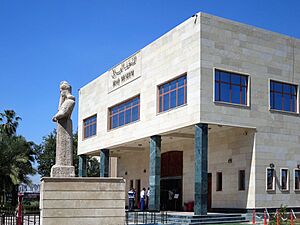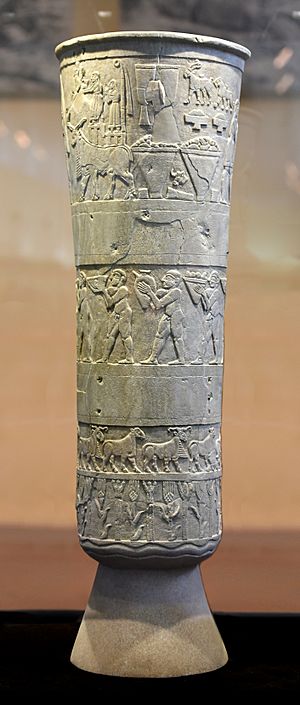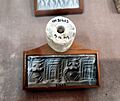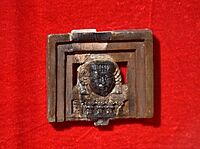Iraq Museum facts for kids

Entrance of the Iraq Museum
|
|
| Established | 1926 |
|---|---|
| Location | Baghdad, Iraq |
| Collection size | 170,000 – 200,000 |
| Visitors | Open |
The Iraq Museum (Arabic: المتحف العراقي) is the national museum of Iraq. It is located in Baghdad, the capital city. People sometimes call it the National Museum of Iraq. This museum holds amazing treasures from ancient civilizations. These include items from Mesopotamia, the Abbasid period, and Persia.
Sadly, the museum was robbed during and after the 2003 Invasion of Iraq. Many valuable items were stolen. Even with help from around the world, only some of these stolen artifacts have been returned. The museum was closed for many years for repairs. It officially reopened in February 2015 and is now open to the public.
Contents
How the Museum Started
After World War I, experts called archaeologists started digging in Iraq. They found many ancient objects. To keep these important finds in Iraq, Gertrude Bell began collecting them. She was a British traveler, spy, archaeologist, and writer. In 1922, she started gathering artifacts in a government building in Baghdad.
On June 14, 1926, the Iraqi government moved the collection. They put it in a new building and created the Baghdad Antiquities Museum. Gertrude Bell became its first director. She passed away later that year. Sidney Smith then became the new director.
In 1966, the collection moved again. It went to a large, two-story building in Baghdad. This new building was in the Al-Ṣāliḥiyyah neighborhood, near the Tigris River. When it moved, the museum's name changed to the Iraq Museum. Before that, it was known as the Baghdad Archaeological Museum.
Bahija Khalil became the museum's director in 1983. She was the first woman to hold this important job. She led the museum until 1989.
Amazing Collections
Mesopotamia was a very rich area for ancient discoveries. Because of this, the Iraq Museum's collections are considered some of the most important in the world. The museum has a great history of showing and studying these items. Since Britain had a connection with Iraq and the museum, all exhibits are shown in both English and Arabic.
The museum has 28 galleries and storage areas. They hold important artifacts from Mesopotamia's history, which goes back over 5,000 years. The collections include art and objects from ancient Sumerian, Assyrian, and Babylonian civilizations. There are also galleries with pre-Islamic and Islamic Arabian art and artifacts.
Some of the most special collections are:
- The Nimrud gold collection: This includes gold jewelry and figures made of precious stones. They are from the 9th century BCE (about 2,900 years ago).
- The Uruk collection: This has stone carvings and cuneiform tablets. These treasures are from between 3500 and 3000 BCE (about 5,000 to 5,500 years ago).
Damage and Losses in 2003

Before the Iraq War in 2003, many experts asked the U.S. and UK governments to protect the museum. They wanted to keep it safe from fighting and theft. However, no promises were made. U.S. forces did not bomb the museum itself.
On April 9, 2003, the museum staff, including director Nawala Al-Mutawalli, left the building. Fighting was happening nearby. The museum staff had tried to protect large artifacts by covering them with foam and sandbags. They also built a wall for protection.
Sadly, thefts happened between April 10 and 12. When some museum staff returned on April 12, they tried to stop more thieves. U.S. forces arrived to secure the museum on April 16. A special team started an investigation on April 21. They found that three different groups of thieves had stolen items over four days.
About 40 valuable pieces were stolen from the main galleries. By January 2005, only 13 of these had been found. This included three very important items:
- The Sacred Vase of Warka: A Sumerian vase over 5,000 years old. It was found broken into 14 pieces, which was its original state when first discovered.
- The Mask of Warka: An ancient face sculpture.
- The Bassetki Statue: A bronze statue of a young man from the Akkadian period (around 2300 BCE).
Other stolen items included the Harp of Ur, which was broken apart for its gold. Also, a stone statue of King Schalmanezer from the 8th century BCE was taken.
Thieves also raided the museum's storage rooms. About 3,100 smaller items like jars and pottery pieces were stolen from above-ground storage. Most of these (3,000) have been recovered. In the underground storage, thieves tried to steal small, easy-to-carry objects. They took about 10,000 small items like cylinder seals, beads, and jewelry. Only about 2,500 of these have been found.
One of the most valuable items stolen was a headless stone statue of the Sumerian king Entemena of Lagash. This statue is about 4,400 years old. It weighs hundreds of pounds. Thieves likely rolled or slid it down the marble stairs, damaging the stairs and other artifacts. This statue was later found in the United States and returned to Iraq in July 2006.
Global Reaction to the Looting
Many people around the world were upset that the museum was not protected. Experts from the British Museum said the looting was "entirely predictable." Some U.S. officials resigned to protest the lack of protection.
At first, news reports said that as many as 170,000 items were stolen. This was based on a misunderstanding. Many display cases were empty because curators had hidden objects before the war. The actual number of stolen items was around 15,000, including 5,000 very valuable cylinder seals.
French President Jacques Chirac called the looting "a crime against humanity." U.S. officials said their priority was the fighting, not guarding the museum. Secretary of Defense Donald Rumsfeld described the looting as "untidiness." However, the U.S. later promised to help recover the artifacts.
Dr. Donny George Youkhanna, a director at the Board of Antiquities in Iraq, called the looting "the crime of the century." He said it affected the heritage of all mankind.
Efforts to Get Items Back
Soon after the thefts, agents from the FBI went to Iraq to search for stolen museum property. UNESCO held a meeting in Paris to discuss the looting and its impact on the art market.
In the United States, the Baghdad Museum Project was started. Its goal was to help return the museum's collection safely. They worked to create an online catalog of all artifacts and a virtual museum.
By May 2003, U.S. Customs agents and museum experts had recovered almost 40,000 manuscripts and 700 artifacts. Some looters returned items after being promised rewards or forgiveness. Many items thought to be missing had actually been hidden in secret vaults before the war. In June 2003, world-famous treasures from Nimrud, including gold jewelry, were found safe in a secret vault. However, about 15,000 small, valuable items are still missing.
The museum has been protected since the looting. But many other ancient sites in Iraq were left unprotected. This led to massive looting of those sites. Estimates suggest that 400,000 to 600,000 artifacts were stolen from these sites between 2003 and 2007.
Mohammed Ghani Hikmat, an Iraqi sculptor, led efforts to get stolen artworks back. About 150 of his own pieces were stolen from the museum. By September 2011, his group had recovered about 100 of the museum's works.
United States Marine Colonel Matthew Bogdanos led the search for stolen artifacts for over five years. By 2006, his efforts helped recover about 10,000 artifacts. These included the Warka Vase and the Mask of Warka.
The Oriental Institute (Chicago) created a webpage called "Lost Treasures from Iraq" in April 2003. It shared information about lost or stolen artifacts. However, this website was last updated in April 2008. Some items listed as stolen or "status unknown" were later found to be safe in the Iraq Museum or other museums in Iraq. This showed there was some confusion in the records.
Recent Work and Reopening
At various conferences, the Baghdad Museum Project spoke about protecting Iraq's cultural heritage. In August 2006, Iraq's museum director, Dr. Donny Youkhanna, left the country for Syria. He had received threats from groups targeting Iraqi thinkers.
In June 2009, the Iraq Museum's treasures became available online for the first time. Italy launched the Virtual Museum of Iraq. In November 2009, Google announced it would create its own virtual copy of the museum's collections. This would make images of thousands of years of treasures available online for free. Google's Street View service was used to photograph the museum's exhibit areas. These images have been online since November 2011.
In 2017, forty ancient Iraqi artifacts from the Iraq Museum were shown at the Venice Biennale. These items spanned 6,000 years of history. Most had never left Iraq before. Some were recently recovered after the 2003 looting. This exhibition was very popular and received good reviews.
Official Reopening
The museum was only open sometimes between 1980 (during the Iran-Iraq War) and 2015. After the 2003 invasion, it was rarely open. It had a brief opening in July 2003 for journalists. In December 2008, it opened for a photo opportunity. On February 23, 2009, the museum opened at the request of the Iraqi prime minister. Many experts protested this opening, saying it was not yet safe enough. The museum's director was even fired for speaking out.
At the official reopening ceremony, Iraq's tourism minister said that only 6,000 of the 15,000 items stolen in 2003 had been returned. By September 2011, Iraqi officials announced the renovated museum would permanently reopen in November. It would have new climate control and security systems. The United States and Italian governments helped with the renovation.
On February 28, 2015, the museum was officially reopened by Iraqi Prime Minister Haider al-Abadi. The museum also displays items from the Mosul Museum, as ISIS had taken over that museum.
Recovery Efforts
On September 7, 2010, 540 looted treasures were returned to Iraq. In another instance, 638 stolen artifacts were found in the office of Prime Minister Nouri al-Maliki and returned to the museum.
On January 30, 2012, Germany returned 45 ancient items to Iraq. These included a 6,500-year-old Sumerian gold jar, a Sumerian battle axe head, and a stone from an Assyrian palace. At that time, about 10,000 pieces from the Iraq Museum were still missing.
On August 3, 2021, news sites reported that the U.S. had returned 17,000 looted ancient artifacts to Iraq. These items had been part of the collection at the Museum of the Bible.
On March 8, 2023, the Federal Bureau of Investigation (FBI) returned a 7,500-year-old ivory and gold leaf furniture piece. It had been on display at the Michael C. Carlos Museum. The museum bought the artifact in 2006, believing it had been in the U.S. since 1969. However, FBI agents found that the records were false. The museum gave the artifact to the FBI in December 2022. The FBI stated this was the first time an artifact stolen from the Iraq Museum was found in an American museum.
Images for kids
-
Head of a Sumerian male worshipper from Tell Asmar (Eshnunna), Iraq, on display at the Sulaymaniyah Museum, Iraq since 1961.
Gallery
-
Sumerian worshiper from Tell Asmar
-
Throne dais of Shalmaneser III from Fort Shalmaneser
See also
 In Spanish: Museo Nacional de Irak para niños
In Spanish: Museo Nacional de Irak para niños
- Sulaymaniyah Museum
- Erbil Civilization Museum
- Basrah Museum
- Art of Mesopotamia
- List of museums in Iraq
- Lyres of Ur
- Taha Baqir
- Archaeological looting in Iraq
News and Editorials
- The Ghost in the Baghdad Museum, The New York Times, April 2, 2006.
- Thousands of Iraqi artifacts found, CNN, May 7, 2003.
- Missing Antiquities: Loss Estimates Are Cut on Iraqi Artifacts, but Questions Remain, The New York Times, May 1, 2003.
- Relics: Experts' Pleas to Pentagon Didn't Save Museum, The New York Times, April 16, 2003.
- Antiquities: Curators Appeal for a Ban on Purchase of Iraqi Artifacts, The New York Times, April 16, 2003.
- Hundreds of looted items returned to Iraqi museum, CNN Web Site, November 11, 2003.
- Iraq and Ruin, The Guardian, May 2, 2003, Neal Ascherson interview with Donny George.
- Donny George: A Real-Life Treasure Hunt, Newsweek, March 21, 2005.























